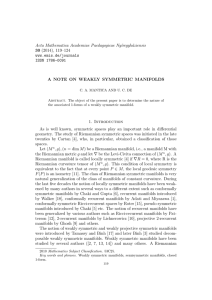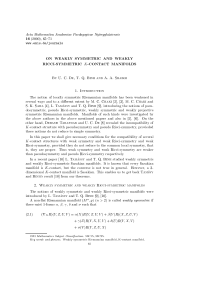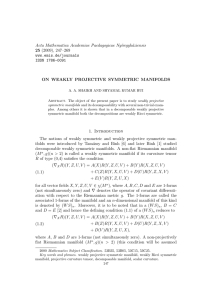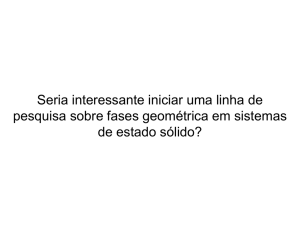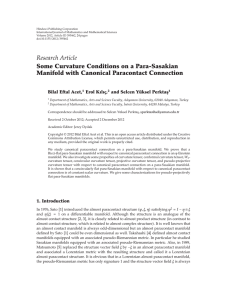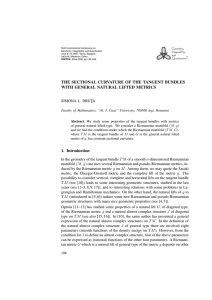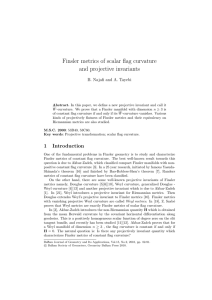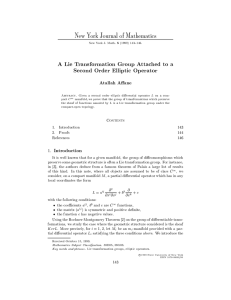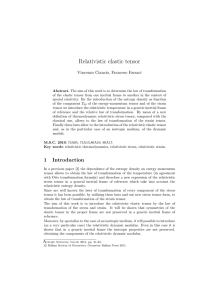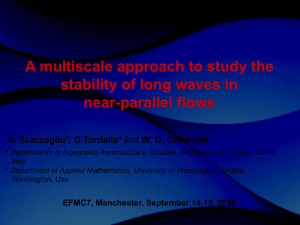60 (2008), 269–284 ON WEAKLY CONFORMALLY SYMMETRIC MANIFOLDS
advertisement
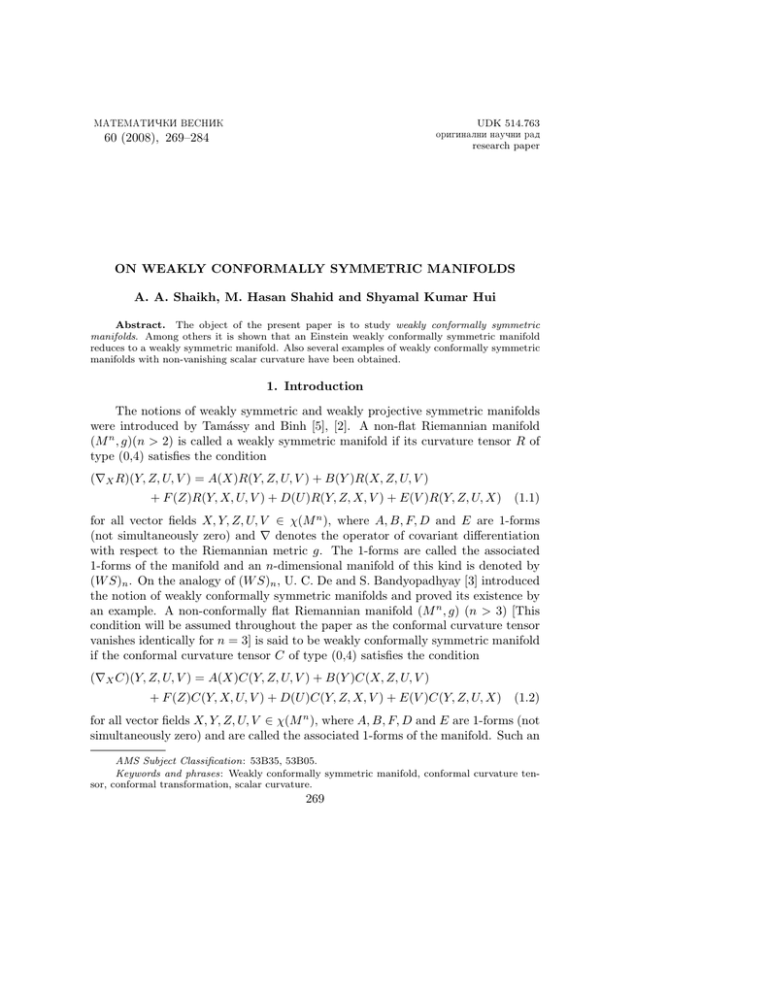
MATEMATIQKI VESNIK
UDK 514.763
originalni nauqni rad
research paper
60 (2008), 269–284
ON WEAKLY CONFORMALLY SYMMETRIC MANIFOLDS
A. A. Shaikh, M. Hasan Shahid and Shyamal Kumar Hui
Abstract. The object of the present paper is to study weakly conformally symmetric
manifolds. Among others it is shown that an Einstein weakly conformally symmetric manifold
reduces to a weakly symmetric manifold. Also several examples of weakly conformally symmetric
manifolds with non-vanishing scalar curvature have been obtained.
1. Introduction
The notions of weakly symmetric and weakly projective symmetric manifolds
were introduced by Tamássy and Binh [5], [2]. A non-flat Riemannian manifold
(M n , g)(n > 2) is called a weakly symmetric manifold if its curvature tensor R of
type (0,4) satisfies the condition
(∇X R)(Y, Z, U, V ) = A(X)R(Y, Z, U, V ) + B(Y )R(X, Z, U, V )
+ F (Z)R(Y, X, U, V ) + D(U )R(Y, Z, X, V ) + E(V )R(Y, Z, U, X)
(1.1)
n
for all vector fields X, Y, Z, U, V ∈ χ(M ), where A, B, F, D and E are 1-forms
(not simultaneously zero) and ∇ denotes the operator of covariant differentiation
with respect to the Riemannian metric g. The 1-forms are called the associated
1-forms of the manifold and an n-dimensional manifold of this kind is denoted by
(W S)n . On the analogy of (W S)n , U. C. De and S. Bandyopadhyay [3] introduced
the notion of weakly conformally symmetric manifolds and proved its existence by
an example. A non-conformally flat Riemannian manifold (M n , g) (n > 3) [This
condition will be assumed throughout the paper as the conformal curvature tensor
vanishes identically for n = 3] is said to be weakly conformally symmetric manifold
if the conformal curvature tensor C of type (0,4) satisfies the condition
(∇X C)(Y, Z, U, V ) = A(X)C(Y, Z, U, V ) + B(Y )C(X, Z, U, V )
+ F (Z)C(Y, X, U, V ) + D(U )C(Y, Z, X, V ) + E(V )C(Y, Z, U, X)
(1.2)
for all vector fields X, Y, Z, U, V ∈ χ(M n ), where A, B, F, D and E are 1-forms (not
simultaneously zero) and are called the associated 1-forms of the manifold. Such an
AMS Subject Classification: 53B35, 53B05.
Keywords and phrases: Weakly conformally symmetric manifold, conformal curvature tensor, conformal transformation, scalar curvature.
269
270
A. A. Shaikh, M. H. Shahid, Sh. K. Hui
n-dimensional manifold is denoted by (W CS)n . Also in [3] the authors proved that
in a (W CS)n , the associated 1-forms B = F and D = E and hence the defining
condition (1.2) of a (W CS)n reduces to the following form [3]:
(∇X C)(Y, Z, U, V ) = A(X)C(Y, Z, U, V ) + B(Y )C(X, Z, U, V )
+ B(Z)C(Y, X, U, V ) + D(U )C(Y, Z, X, V ) + D(V )C(Y, Z, U, X).
(1.3)
This paper presents a study of (W CS)n . In section 2, it is shown that if in a
(W CS)n , the Ricci tensor vanishes then it reduces to a (W S)n . Also it is proved
that in a (W CS)n satisfying the condition A(C(Y, Z)U ) + D(C(Y, Z)U ) = 0, the
Ricci tensor is of Codazzi type if and only if the scalar curvature is constant.
Section 3 is concerned with Einstein (W CS)n and proved that such a manifold
is (W S)n . In section 4 we study conformal transformation in a (W CS)n and
we prove that if a (W CS)n is transformed into another (W CS)n under such a
transformation then the transformation is homothetic. In [3] the authors gave an
example of a (W CS)n which was of zero scalar curvature. Natural question arises
whether there exists or not (W CS)n of non-zero scalar curvature? The last section
provides the answer to this question affirmatively by several examples.
2. Some basic results of (W CS)n
In this section, we derive some formulas, which will be needed to the study of
a (W CS)n . The Weyl conformal curvature tensor C of type (0,4) is given by
1
[S(Y, Z)g(X, W )
n−2
− S(X, Z)g(Y, W ) + g(Y, Z)S(X, W ) − g(X, Z)S(Y, W )]
r
+
[g(Y, Z)g(X, W ) − g(X, Z)g(Y, W )],
(n − 1)(n − 2)
C(X, Y, Z, W ) = R(X, Y, Z, W ) −
(2.1)
where R, S, r denotes respectively the Riemannian curvature tensor of type (0,4),
the Ricci tensor of type (0,2) and the scalar curvature of the manifold.
From (2.1), it follows that
n
P
i=1
C(ei , Y, Z, ei ) = 0 =
n
P
i=1
C(Y, ei , ei , Z),
(2.2)
where {ei : i = 1, 2, . . . , n} is an orthonormal basis of the tangent space at any
point of the manifold.
From (2.1) it follows by virtue of Bianchi identity that
(∇X C)(Y, Z, U, V ) + (∇Y C)(Z, X, U, V ) + (∇Z C)(X, Y, U, V ) =
1
[g(Y, V ){(∇X S)(Z, U ) − (∇Z S)(X, U )} + g(Z, V ){(∇Y S)(X, U )
=−
n−2
− (∇X S)(Y, U )} + g(Z, U ){(∇X S)(Y, V ) − (∇Y S)(X, V )}
+ g(Y, U ){(∇Z S)(X, V ) − (∇X S)(Z, V )} + g(X, V ){(∇Z S)(Y, U )
On weakly conformally symmetric manifolds
271
− (∇Y S)(Z, U )} + g(X, U ){(∇Y S)(Z, V ) − (∇Z S)(Y, V )}]
1
+
[dr(X){g(Z, U )g(Y, V ) − g(Y, U )g(Z, V )}
(n − 1)(n − 2)
+ dr(Y ){g(X, U )g(Z, V ) − g(Z, U )g(X, V )}
+ dr(Z){g(Y, U )g(X, V ) − g(X, U )g(Y, V )}].
(2.3)
If the Ricci tensor is of Codazzi type [4], i.e., if
(∇X S)(Z, U ) = (∇Z S)(X, U ),
then dr(X) = 0 for all X and hence from (2.3) we obtain
(∇X C)(Y, Z, U, V ) + (∇Y C)(Z, X, U, V ) + (∇Z C)(X, Y, U, V ) = 0.
(2.4)
Hence we can state the following:
Proposition 2.1. If in a Riemannian manifold (M n , g) (n > 3), the Ricci
tensor is of Codazzi type, then the second Bianchi identity of the conformal curvature tensor C has just the same form as that of the curvature tensor R of M n .
Again if a Riemannian manifold satisfies the relation (2.4), then (2.3) yields
g(Y, V ){(∇X S)(Z, U ) − (∇Z S)(X, U )} + g(Z, V ){(∇Y S)(X, U )
− (∇X S)(Y, U )} + g(Z, U ){(∇X S)(Y, V ) − (∇Y S)(X, V )}
+ g(Y, U ){(∇Z S)(X, V ) − (∇X S)(Z, V )} + g(X, V ){(∇Z S)(Y, U )
− (∇Y S)(Z, U )} + g(X, U ){(∇Y S)(Z, V ) − (∇Z S)(Y, V )}
1
−
[dr(X){g(Z, U )g(Y, V ) − g(Y, U )g(Z, V )}
(n − 1)
+ dr(Y ){g(X, U )g(Z, V ) − g(Z, U )g(X, V )}
+ dr(Z){g(Y, U )g(X, V ) − g(X, U )g(Y, V )}] = 0.
(2.5)
Putting Y = V = ei in (2.5) and taking summation over i, 1 ≤ i ≤ n, we obtain
(∇X S)(Z, U ) − (∇Z S)(X, U ) =
1
[dr(X)g(Z, U ) − dr(Z)g(X, U )].
2(n − 1)
(2.6)
If r is a constant then (2.6) yields that the Ricci tensor is of Codazzi type. This
leads to the following:
Proposition 2.2. If a Riemannian manifold (M n , g) (n > 3) with constant
scalar curvature satisfies the relation (2.4) then the Ricci tensor is of Codazzi type.
Setting Y = V = ei in (1.3) and then using (2.2), it follows that
B(C(X, Z)U ) + D(C(X, U )Z) = 0
for all X, Z, U . Thus we have the following:
(2.7)
272
A. A. Shaikh, M. H. Shahid, Sh. K. Hui
Proposition 2.3. In a (W CS)n , the relation (2.7) holds.
In view of (2.1), (2.7) yields
1
[S(Z, U ){B(X) + D(X)}
n−2
+ g(Z, U ){B(QX) + D(QX)} − S(X, U )B(Z) − S(X, Z)D(U )
r
− g(X, U )B(QZ) − g(X, Z)D(QU )] +
[g(Z, U )
(n − 1)(n − 2)
{B(X) + D(X)} − g(X, U )B(Z) − g(X, Z)D(U )] = 0,
B(R(X, Z)U ) + D(R(X, U )Z) −
(2.8)
where Q is the Ricci-operator i.e., g(QX, Y ) = S(X, Y ).
Now, if the Ricci tensor vanishes i.e., if S(X, Y ) = 0 for all X, Y then (2.1)
implies that C(X, Y, Z, W ) = R(X, Y, Z, W ) and hence (1.2) reduces to (1.1). Also
for S(X, Y ) = 0, (2.8) yields
B(R(X, Z)U ) + D(R(X, U )Z) = 0
(2.9)
for all vector fields X, Z, U on the manifold. Thus we can state the following:
Proposition 2.4. A (W CS)n with vanishing Ricci tensor is a (W S)n and
satisfies the relation (2.9).
Again from (1.3) it follows that
(divC)(Y, Z)U = A(C(Y, Z)U ) + D(C(Y, Z)U )
(2.10)
where ‘div’ denotes the divergence. Also in a Riemannian manifold (M n , g) (n > 3)
we have
(divC)(X, Y )Z =
n−3
[{(∇X S)(Y, Z) − (∇Y S)(X, Z)}
n−2
1
−
{g(Y, Z)dr(X) − g(X, Z)dr(Y )}].
2(n − 1)
(2.11)
In view of (2.7) and (2.10), it follows that
(divC)(Y, Z)U = A(C(Y, Z)U ) − B(C(Y, U )Z).
(2.12)
A Riemannian manifold with div C = 0 is said to be of harmonic conformal curvature [1].
This leads to the following:
Proposition 2.5. A (W CS)n is of harmonic conformal curvature if and only
if A(C(Y, Z)U ) = B(C(Y, U )Z) for all vector fields Y, Z, U .
We now suppose that a (W CS)n satisfies the relation
A(C(Y, Z)U ) = B(C(Y, U )Z)
(2.12a)
On weakly conformally symmetric manifolds
273
for all vector fields Y, Z, U . Then (2.12) yields
(divC)(Y, Z)U = 0.
(2.13)
In view of (2.13) and (2.11) we obtain
(∇X S)(Y, Z) − (∇Y S)(X, Z) =
1
{g(Y, Z)dr(X) − g(X, Z)dr(Y )}. (2.14)
2(n − 1)
From (2.14), it follows that if the scalar curvature r is constant, then
(∇X S)(Y, Z) = (∇Y S)(X, Z)
for all X, Y, Z, which means that the Ricci tensor is of Codazzi type [4]. Conversely,
if the Ricci tensor is of Codazzi type, then (2.14) implies that r is a constant. Hence
we can state the following:
Proposition 2.6. Let (M n , g) (n > 3) be a (W CS)n satisfying the relation (2.12a). Then the Ricci tensor is of Codazzi type if and only if its scalar
curvature is a constant.
3. Einstein (W CS)n
Let us consider a (W CS)n , which is Einstein. Then we have
S(X, Y ) =
r
g(X, Y ),
n
which yields (∇Z S)(X, Y ) = 0 and hence dr(X) = 0 for all X.
of (3.1), (2.1) takes the form
(3.1)
By virtue
r
[g(Y, Z)g(X, W ) − g(X, Z)g(Y, W )].
n(n − 1)
(3.2)
In view of (3.2), (1.3) reduces to the following:
C(X, Y, Z, W ) = R(X, Y, Z, W ) −
(∇X R)(Y, Z, U, V )
r
{g(Z, U )g(Y, V ) − g(Y, U )g(Z, V )}]
n(n − 1)
r
+ B(Y )[R(X, Z, U, V ) −
{g(Z, U )g(X, V ) − g(X, U )g(Z, V )}]
n(n − 1)
r
+ B(Z)[R(Y, X, U, V ) −
{g(X, U )g(Y, V ) − g(Y, U )g(X, V )}]
n(n − 1)
r
+ D(U )[R(Y, Z, X, V ) −
{g(Z, X)g(Y, V ) − g(Y, X)g(Z, V )}]
n(n − 1)
r
{g(Z, U )g(Y, X) − g(Y, U )g(Z, X)}]. (3.3)
+ D(V )[R(Y, Z, U, V ) −
n(n − 1)
= A(X)[R(Y, Z, U, V ) −
274
A. A. Shaikh, M. H. Shahid, Sh. K. Hui
Applying Bianchi identity, it follows from (3.3) that
A(X)R(Y, Z, U, V ) + A(Y )R(Z, X, U, V ) + A(Z)R(X, Y, U, V )
+ B(Y )R(X, Z, U, V ) + B(Z)R(Y, X, U, V ) + B(X)R(Z, Y, U, V )
r
−
[{A(X) − 2B(X)}{g(Z, U )g(Y, V ) − g(Y, U )g(Z, V )}
n(n − 1)
+ {A(Y ) − 2B(Y )}{g(X, U )g(Z, V ) − g(Z, U )g(X, V )}
+ {A(Z) − 2B(Z)}{g(Y, U )g(X, V ) − g(X, U )g(Y, V )}] = 0.
(3.4)
Putting Y = V = ei in (3.4) and then taking summation over i, 1 ≤ i ≤ n, we get
[A(X) − B(X)]S(Z, U ) − [A(Z) − B(Z)]S(X, U ) + A(R(Z, X)U )
− B(R(Z, X)U ) −
(n − 2)r
[{A(X) − 2B(X)}g(Z, U )
n(n − 1)
− {A(Z) − 2B(Z)}g(X, U )] = 0.
(3.5)
Again setting Z = U = ei in (3.5) and taking summation over i, 1 ≤ i ≤ n, we
obtain
r[A(X) − B(X)] − 2[A(QX) − B(QX)] −
(n − 2)r
[A(X) − 2B(X)] = 0.
n
(3.6)
From (3.1) we have
A(QX) =
r
r
A(X) and B(QX) = B(X).
n
n
Using the above in (3.6) we obtain rB(X) = 0, which yields r = 0, since B(X) 6= 0.
Consequently (3.1) implies that S(X, Y ) = 0 for all X, Y and hence by Proposition 2.4., the manifold is a (W S)n . Thus we can state the following:
Theorem 3.1. An Einstein (W CS)n is of vanishing scalar curvature and
hence is a (W S)n .
4. Conformal transformation of (W CS)n
Let (M n , g)(n > 3) be an n-dimensional Riemannian manifold with the metric
∗
tensor g. Let ρ be a positive function on M . Then g = ρ2 g defines a change of
metric on M which does not change the angle between two vectors at any point
p ∈ M and is called a conformal transformation. In particular, if the function ρ is
a positive constant, then the conformal transformation is said to be homothetic.
∗
∗
If ∇ denotes the operator of covariant differentiation with respect to g, then
we have [6]
∗
∇X Y = ∇X Y + ω(Y )X + ω(X)Y − g(X, Y )U
(4.1)
for any vector fields X, Y where ω is a 1-form defined by ω = d(logρ) and U is a
vector field defined by
ω(X) = g(X, U ).
275
On weakly conformally symmetric manifolds
Since the conformal curvature tensor is invariant under conformal transformation,
we have
∗
C(X, Y, Z, W ) = C(X, Y, Z, W ),
(4.2)
∗
where each object denoted by ‘∗’ is from M . Differentiating (4.2) covariantly and
then using (4.1) we obtain
∗
∗
(∇X C)(Y, Z, W, V ) = (∇X C)(Y, Z, W, V ) − 2ω(X)C(Y, Z, W, V )
− ω(Y )C(X, Z, W, V ) − ω(Z)C(Y, X, W, V ) − ω(W )C(Y, Z, X, V )
+ g(X, Y )C(U, Z, W, V ) + g(X, Z)C(Y, U, W, V )
+ g(X, W )C(Y, Z, U, V ) − C(Y, Z, W, X)U. (4.3)
∗
We now suppose that both M and M are (W CS)n . Then we have the relation (1.3)
and
∗
∗
∗
∗
∗
∗
(∇X C)(Y, Z, W, V ) = A(X)C(Y, Z, W, V ) + B(Y )C(X, Z, W, V )
∗
∗
∗
∗
∗
∗
+ B(Z)C(Y, X, W, V ) + D(W )C(Y, Z, X, V ) + D(V )C(Y, Z, W, X),
∗
∗
∗
∗
(4.4)
∗
where A, B, D are non-zero 1-forms such that g(X, ρ1 ) = A(X) and so on. By
virtue of (4.2) and (4.4) we obtain from (4.3) that
∗
∗
[A(X) − A(X)]C(Y, Z, W, V ) + [B(Y ) − B(Y )]C(X, Z, W, V )+
∗
∗
[B(Z) − B(Z)]C(Y, X, W, V ) + [D(W ) − D(W )]C(Y, Z, X, V )+
∗
[D(V ) − D(V )]C(Y, Z, W, X) + 2ω(X)C(Y, Z, W, V ) + ω(Y )C(X, Z, W, V )
+ ω(Z)C(Y, X, W, V ) + ω(W )C(Y, Z, X, V ) − g(X, Y )C(U, Z, W, V )
− g(X, Z)C(Y, U, W, V ) − g(X, W )C(Y, Z, U, V ) − C(Y, Z, W, X)ω(V ) = 0.
(4.5)
Putting W = V = ei in (4.5) and then taking summation over i, 1 ≤ i ≤ n, we get
ω(C(Y, Z)X) = 0 for all Y, Z, X.
(4.6)
This implies that
C(Y, Z, U, V ) = C(Y, Z, V, U ) = C(U, V, Y, Z) = C(V, U, Y, Z) = 0.
Hence using these relations, (4.5) reduces to
∗
∗
[A(X) − A(X)]C(Y, Z, W, V ) + [B(Y ) − B(Y )]C(X, Z, W, V )
∗
∗
+ [B(Z) − B(Z)]C(Y, X, W, V ) + [D(W ) − D(W )]C(Y, Z, X, V )
∗
+ [D(V ) − D(V )]C(Y, Z, W, X) + 2ω(X)C(Y, Z, W, V )+
ω(Y )C(X, Z, W, V ) + ω(Z)C(Y, X, W, V ) + ω(W )C(Y, Z, X, V ) = 0.
(4.7)
276
A. A. Shaikh, M. H. Shahid, Sh. K. Hui
∗
∗
∗
We now first suppose that A(X) = A(X), B(X) = B(X) and D(X) = D(X) for
all X. Then (4.7) yields
2ω(X)C(Y, Z, W, V ) + ω(Y )C(X, Z, W, V )
+ ω(Z)C(Y, X, W, V ) + ω(W )C(Y, Z, X, V ) = 0.
(4.8)
Setting X = U in (4.8) and then using (4.6) we obtain
2ω(U )C(Y, Z, W, V ) = 0.
Since the manifold is non-conformally flat, we must have ω(U ) = 0, which yields
kU k = 0 and hence ρ = constant. Consequently, the transformation is homothetic.
∗
∗
∗
Next we suppose that A(X) 6= A(X), B(X) 6= B(X) and D(X) 6= D(X).
∗
Suppose, if possible, A(X) − A(X) = ω(X) 6= 0. Then
∗
A(U ) − A(U ) = ω(U ) 6= 0.
(4.9)
Putting X = U in (4.7) and then using (4.6) and (4.9) we get
3ω(U )C(Y, Z, W, V ) = 0,
∗
which is a contradiction as ω(U ) 6= 0 and C 6= 0. Thus we must have A(X) = A(X)
∗
∗
for all X. Similarly it can be shown that B = B and D = D. Hence the associated
1-forms can not be different and the transformation is homothetic. This leads to
the following:
Theorem 4.1. If a (W CS)n is transformed into another (W CS)n under a
conformal transformation, then the associated 1-forms of the manifold are invariant
and the transformation is homothetic.
5. Some examples of (W CS)n
π
2}
be a manifold
ds2 = ex (dx1 )2 + ex (dx1 )2 + (dx3 )2 + sin2 x3 (dx4 )2 .
(5.1)
Example 5.1. Let M 4 = {(x1 , x2 , x3 , x4 ) ∈ R4 : 0 < x3 <
endowed with the metric
1
2
Then the only non-vanishing components of the Christoffel symbols, the curvature
tensor, Ricci tensor, scalar curvature, conformal curvature tensor are given by
1
= Γ222 , Γ344 = − sin x3 cos x3 , Γ434 = cot x3 ,
2
= − sin2 x3 , S33 = −1, S44 = − sin2 x3 , r = −2 6= 0,
1 1
1 1
1 1 2
= − ex +x , C1331 = ex , C1441 = ex sin2 x3 ,
3
6
6
1 x2
1 x2 2 3
1
= e , C2442 = e sin x , C3443 = − sin2 x3
6
6
3
Γ111 =
R3443
C1221
C2332
277
On weakly conformally symmetric manifolds
and the components that can be obtained from these by the symmetry properties. The covariant derivatives of all components of the conformal curvature tensor
vanish. In terms of local coordinate system, if we consider the components of the
1-forms A, B and D as
A(∂i ) = Ai = 0 for i = 1, 2, 3, 4,
B(∂i ) = Bi = 0 for i = 1, 2, 3, 4,
D(∂i ) = Di = 0 for i = 1, 2, 3, 4,
∂
4
where ∂i = ∂x
i , then one can easily prove that (M , g) is a conformally symmetric
manifold, which is a trivial (W CS)4 . Thus we can state the following:
Theorem 5.1. Let (M 4 , g) be a Riemannian manifold endowed with the metric
given in (5.1). Then (M 4 , g) is a weakly conformally symmetric manifold with nonvanishing scalar curvature, which is conformally symmetric.
Example 5.2. Let M 4 = {(x1 , x2 , x3 , x4 ) ∈ R4 : x3 6= 0} be a manifold
endowed with the metric
ds2 = gij dxi dxj = f (dx1 )2 + 2dx1 dx2 + (dx3 )2 + (dx4 )2 , (i, j = 1, 2, 3, 4), (5.2)
1
3 2
3 4
3 6
3 2n+2
)
where f = a0 + a1 x3 + ex { (x2!) + (x4!) + (x6!) + · · · + (x
(2n+2)! + . . . }, a0 , a1 are
non-constant functions of x1 only. Then the only non-vanishing components of the
Christoffel symbols, the curvature tensor, Ricci tensor, scalar curvature, conformal
curvature tensor and its covariant derivatives are given by
1
1
f.1 , Γ213 = f.3 = −Γ311 ,
2
2
1
1 x1
R1331 = f.33 = e cosh x3 = S11 , r = 0,
2
2
1
1 1
C1331 = f.33 = ex cosh x3 = −C1441 ,
4
4
1 1
(5.3)
C1331,1 = ex cosh x3 ,
4
1 1
(5.4)
C1331,3 = ex sinh x3 ,
2
1 1
C1441,1 = − ex cosh x3 ,
(5.5)
4
1 1
C1441,3 = − ex sinh x3
(5.6)
2
and the components that can be obtained from these by the symmetry properties,
where ‘.’ denotes the partial differentiation with respect to the coordinates, ‘,’
denotes the covariant differentiation with respect to the metric tensor g, and r is
the scalar curvature of the manifold whose value is zero here. Therefore, our M 4
with the considered metric is a Riemannian manifold which is neither conformally
flat nor conformally symmetric and is of vanishing scalar curvature.
Γ211 =
278
A. A. Shaikh, M. H. Shahid, Sh. K. Hui
In terms of local coordinate system, let us consider the 1-forms A, B, D as
follows:
3
for i = 1,
10
3
A(∂i ) = Ai =
tanh x
for i = 3,
0
otherwise ,
½ 1
for i = 1,
B(∂i ) = Bi = 5
(5.7)
0 otherwise ,
½ 1
for i = 1,
D(∂i ) = Di = 2
0 otherwise ,
∂
where ∂i = ∂x
i . In terms of local coordinate system, the defining condition (1.3)
of a (W CS)n can be written as
Cijkl,p = Ap Cijkl + Bi Cpjkl + Bj Cipkl + Dk Cijpl + Dl Cijkp ,
(5.8)
which reduces with these 1-forms to the following equations:
C1331,i = Ai C1331 + B1 Ci331 + B3 C1i31 + D3 C13i1 + D1 C133i ,
(5.9)
C1441,i = Ai C1441 + B1 Ci441 + B4 C1i41 + D4 C14i1 + D1 C144i ,
(5.10)
C1332,i = Ai C1332 + B1 Ci332 + B3 C1i32 + D3 C13i2 + D2 C133i ,
(5.11)
C1334,i = Ai C1334 + B1 Ci334 + B3 C1i34 + D3 C13i4 + D4 C133i ,
(5.12)
C3112,i = Ai C3112 + B3 Ci112 + B1 C3i12 + D1 C31i2 + D2 C311i ,
(5.13)
C3114,i = Ai C3114 + B3 Ci114 + B1 C3i14 + D1 C31i4 + D4 C311i ,
(5.14)
C1442,i = Ai C1442 + B1 Ci442 + B4 C1i42 + D4 C14i2 + D2 C144i ,
(5.15)
C1443,i = Ai C1443 + B1 Ci443 + B4 C1i43 + D4 C14i3 + D3 C144i ,
(5.16)
C4112,i = Ai C4112 + B4 Ci112 + B1 C4i12 + D1 C41i2 + D2 C411i ,
(5.17)
where i = 1, 2, 3, 4, since for the cases other than (5.9)–(5.17), the components of
each term of (5.8) either vanishes identically or the relation (5.8) holds trivially
using the skew-symmetry property of C.
Now, from (5.3) and (5.7), it follows that, for i = 1, right hand side of (5.9)
1
= (A1 + B1 + D1 )C1331 = 41 ex cosh x3 = C1331,1 = left hand side of (5.9). For
i = 2, 3, 4, the relation (5.7) implies that both sides of equation (5.9) are equal. By
the similar argument, it can be easily seen that the equations (5.10)–(5.17) holds.
Thus, the manifold under consideration is weakly conformally symmetric manifold.
Hence we can state the following:
Theorem 5.2. Let (M 4 , g) be a Riemannian manifold endowed with the metric
given in (5.2). Then (M 4 , g) is a weakly conformally symmetric manifold with
vanishing scalar curvature which is neither conformally symmetric nor conformally
recurrent.
On weakly conformally symmetric manifolds
279
Example 5.3. Let M 4 = {(x1 , x2 , x3 , x4 ) ∈ R4 : x3 6= 0} be a manifold
endowed with the metric
ds2 = gij dxi dxj = sinh x3 [(dx1 )2 + (dx3 )2 ] + (dx2 )2 + (dx4 )2 ,
(5.18)
(i, j = 1, 2, 3, 4). Then the only non-vanishing components of the Christoffel symbols, the curvature tensor, Ricci tensor, scalar curvature, conformal curvature tensor and its covariant derivatives are given by
1
1
coth x3 = Γ333 = −Γ311 , R1331 = −
,
2
2 sinh x3
1
1
=−
6= 0,
2 3 = S33 , r = −
2 sinh x
sinh3 x3
1
1
, C2442 = −
=−
,
3
6 sinh x
6 sinh3 x3
1
= C1441 = C2332 = C3443 =
,
12 sinh2 x3
coth x3
=
,
2 sinh x3
coth x3
=
,
2 sinh3 x3
coth x3
= C1441,3 = C2332,3 = C3443,3 = −
4 sinh2 x3
Γ113 =
S11
C1331
C1221
C1331,3
C2442,3
C1221,3
(5.19)
(5.20)
(5.21)
and the components that can be obtained from these by the symmetry properties,
where ‘,’ denotes the covariant differentiation with respect to the metric tensor and
Sij denotes the components of the Ricci tensor and r is the scalar curvature of the
manifold. Therefore, the manifold M 4 with the considered metric is a Riemannian
manifold, which is neither conformally flat nor conformally symmetric and is of
non-vanishing scalar curvature.
We shall now show that this (M 4 , g) is a (W CS)4 , that is, it satisfies (1.3).
In terms of local coordinate system, we consider the components of the 1-forms
A, B and D as follows:
½
−3 coth x3 for i = 3,
A(∂i ) = Ai =
0
otherwise ,
B(∂i ) = Bi = 0 for i = 1, 2, 3, 4,
(5.22)
D(∂i ) = Di = 0 for i = 1, 2, 3, 4,
∂
where ∂i = ∂x
i.
In terms of local coordinate system, the defining condition (1.3) of a (W CS)n
can be written as (5.8), which reduces to the following equations:
C1221,i = Ai C1221 + B1 Ci221 + B2 C1i21 + D2 C12i1 + D1 C122i ,
(5.23)
C1331,i = Ai C1331 + B1 Ci331 + B3 C1i31 + D3 C13i1 + D1 C133i ,
(5.24)
280
A. A. Shaikh, M. H. Shahid, Sh. K. Hui
C1441,i = Ai C1441 + B1 Ci441 + B4 C1i41 + D4 C14i1 + D1 C144i ,
(5.25)
C2332,i = Ai C2332 + B2 Ci332 + B3 C2i32 + D3 C23i2 + D2 C233i ,
(5.26)
C2442,i = Ai C2442 + B2 Ci442 + B4 C2i42 + D4 C24i2 + D2 C244i ,
(5.27)
C3443,i = Ai C3443 + B3 Ci443 + B4 C3i43 + D4 C34i3 + D3 C344i ,
(5.28)
C1332,i = Ai C1332 + B1 Ci332 + B3 C1i32 + D3 C13i2 + D2 C133i ,
(5.29)
C1334,i = Ai C1334 + B1 Ci334 + B3 C1i34 + D3 C13i4 + D4 C133i ,
(5.30)
C3112,i = Ai C3112 + B3 Ci112 + B1 C3i12 + D1 C31i2 + D2 C311i ,
(5.31)
C3114,i = Ai C3114 + B3 Ci114 + B1 C3i14 + D1 C31i4 + D4 C311i ,
(5.32)
C1442,i = Ai C1442 + B1 Ci442 + B4 C1i42 + D4 C14i2 + D2 C144i ,
(5.33)
C1443,i = Ai C1443 + B1 Ci443 + B4 C1i43 + D4 C14i3 + D3 C144i ,
(5.34)
C4112,i = Ai C4112 + B4 Ci112 + B1 C4i12 + D1 C41i2 + D2 C411i ,
(5.35)
C2334,i = Ai C2334 + B2 Ci334 + B3 C2i34 + D3 C23i4 + D4 C233i ,
(5.36)
C3221,i = Ai C3221 + B3 Ci221 + B2 C3i21 + D2 C32i1 + D1 C322i ,
(5.37)
C3224,i = Ai C3224 + B3 Ci224 + B2 C3i24 + D2 C32i4 + D4 C322i ,
(5.38)
C2443,i = Ai C2443 + B2 Ci443 + B4 C2i43 + D4 C24i3 + D3 C244i ,
(5.39)
C4221,i = Ai C4221 + B4 Ci221 + B2 C4i21 + D2 C42i1 + D1 C422i ,
(5.40)
where i =1,2,3,4, since for the cases other than (5.23)–(5.40), the components of
each term of (5.8) either vanishes identically or the relation (5.8) holds trivially
using the skew-symmetry property of C.
Now using (5.21) and (5.22), it follows, for i = 3, that right hand side of (5.23)
x3
= A3 C1221 = − 4coth
= C1221,3 = left hand side of (5.23).
sinh2 x3
For i = 1, 2, 4, the relation (5.22) implies that both sides of equation (5.23) are
equal. By the similar arguement, it can be easily seen that the equations (5.24)–
(5.40) hold. Thus the manifold under consideration is weakly conformally symmetric. Hence we can state the following:
Theorem 5.3. Let (M 4 , g) be a Riemannian manifold endowed with the metric
given in (5.18). Then (M 4 , g) is a weakly conformally symmetric manifold with
non-vanishing scalar curvature, which is neither conformally flat nor conformally
symmetric but conformally recurrent.
Example 5.4. Let M = {(x1 , x2 , x3 , . . . , xn ) ∈ Rn : x3 6= 0} be a manifold
endowed with the metric
n
P
(dxk )2 .
(5.41)
ds2 = sinh x3 [(dx1 )2 + (dx3 )2 ] + (dx2 )2 + (dx4 )2 +
k=5
Then the only non-vanishing components of the Christoffel symbols, the curvature
tensor, Ricci tensor, scalar curvature, conformal curvature tensor and its covariant
derivatives are given by
1
Γ113 = coth x3 = Γ333 = −Γ311 ,
2
On weakly conformally symmetric manifolds
1
1
, S11 = −
= S33 ,
2 sinh x3
2 sinh2 x3
1
n−3
r=−
3 3 6= 0, C1331 = − 2(n − 1) sinh x3 ,
sinh x
1
C2442 = C2kk2 = C4kk4 = Cmkkm = −
,
(n − 1)(n − 2) sinh3 x3
C1221 = C1441 = C1kk1 = C2332 = C3443
n−3
= C3kk3 =
,
2(n − 1)(n − 2) sinh2 x3
3(n − 3) coth x3
C1331,3 =
,
2(n − 1) sinh x3
3 coth x3
,
C2442,3 = C2kk2,3 = C4kk4,3 = Cmkkm,3 =
(n − 1)(n − 2) sinh3 x3
281
R1331 = −
(5.42)
(5.43)
C1221,3 = C1441,3 = C1kk1,3 = C2332,3 = C3443,3 = C3kk3,3
=−
3(n − 3) coth x3
for 5 ≤ k ≤ n, 5 ≤ m ≤ n, k 6= m,
2(n − 1)(n − 2) sinh2 x3
(5.44)
and the components that can be obtained from these by the symmetry properties,
where ‘,’ denotes the covariant differentiation with respect to the metric tensor and
Sij denotes the components of the Ricci tensor and r is the scalar curvature of the
manifold. Therefore, the manifold M n with the considered metric is a Riemannian
manifold, which is neither conformally flat nor conformally symmetric and is of
non-vanishing scalar curvature.
In terms of local coordinate system, we consider the components of the 1-forms
A, B and D as follows:
½
−3 coth x3 for i = 3,
A(∂i ) = Ai =
0
otherwise ,
B(∂i ) = Bi = 0 for i = 1, 2, . . . , n,
(5.45)
D(∂i ) = Di = 0 for i = 1, 2, . . . , n,
∂
where ∂i = ∂x
i . In terms of local coordinate system, the defining condition (1.3)
of a (W CS)n can be written as (5.8), which reduces to the following equations:
C1221,i = Ai C1221 + B1 Ci221 + B2 C1i21 + D2 C12i1 + D1 C122i ,
(5.46)
C1331,i = Ai C1331 + B1 Ci331 + B3 C1i31 + D3 C13i1 + D1 C133i ,
(5.47)
C1441,i = Ai C1441 + B1 Ci441 + B4 C1i41 + D4 C14i1 + D1 C144i ,
(5.48)
C1kk1,i = Ai C1kk1 + B1 Cikk1 + Bk C1ik1 + Dk C1ki1 + D1 C1kki ,
(5.49)
C2332,i = Ai C2332 + B2 Ci332 + B3 C2i32 + D3 C23i2 + D2 C233i ,
(5.50)
C2442,i = Ai C2442 + B2 Ci442 + B4 C2i42 + D4 C24i2 + D2 C244i ,
(5.51)
C2kk2,i = Ai C2kk2 + B2 Cikk2 + Bk C2ik2 + Dk C2ki2 + D2 C2kki ,
(5.52)
282
A. A. Shaikh, M. H. Shahid, Sh. K. Hui
C3443,i = Ai C3443 + B3 Ci443 + B4 C3i43 + D4 C34i3 + D3 C344i ,
(5.53)
C3kk3,i = Ai C3kk3 + B3 Cikk3 + Bk C3ik3 + Dk C3ki3 + D3 C3kki ,
(5.54)
C4kk4,i = Ai C4kk4 + B4 Cikk4 + Bk C4ik4 + Dk C4ki4 + D4 C4kki ,
(5.55)
Cmkkm,i = Ai Cmkkm + Bm Cikkm + Bk Cmikm + Dk Cmkim + Dm Cmkki ,
(5.56)
C1223,i = Ai C1223 + B1 Ci223 + B2 C1i23 + D2 C12i3 + D3 C122i ,
(5.57)
C1224,i = Ai C1224 + B1 Ci224 + B2 C1i24 + D2 C12i4 + D4 C122i ,
(5.58)
C122k,i = Ai C122k + B1 Ci22k + B2 C1i2k + D2 C12ik + Dk C122i ,
(5.59)
C2113,i = Ai C2113 + B2 Ci113 + B1 C2i13 + D1 C21i3 + D3 C211i ,
(5.60)
C2114,i = Ai C2114 + B2 Ci114 + B1 C2i14 + D1 C21i4 + D4 C211i ,
(5.61)
C211k,i = Ai C211k + B2 Ci11k + B1 C2i1k + D1 C21ik + Dk C211i ,
(5.62)
C1332,i = Ai C1332 + B1 Ci332 + B3 C1i32 + D3 C13i2 + D2 C133i ,
(5.63)
C1334,i = Ai C1334 + B1 Ci334 + B3 C1i34 + D3 C13i4 + D4 C133i ,
(5.64)
C133k,i = Ai C133k + B1 Ci33k + B3 C1i3k + D3 C13ik + Dk C133i ,
(5.65)
C3114,i = Ai C3114 + B3 Ci114 + B1 C3i14 + D1 C31i4 + D4 C311i ,
(5.66)
C311k,i = Ai C311k + B3 Ci11k + B1 C3i1k + D1 C31ik + Dk C311i ,
(5.67)
C1442,i = Ai C1442 + B1 Ci442 + B4 C1i42 + D4 C14i2 + D2 C144i ,
(5.68)
C1443,i = Ai C1443 + B1 Ci443 + B4 C1i43 + D4 C14i3 + D3 C144i ,
(5.69)
C144k,i = Ai C144k + B1 Ci44k + B4 C1i4k + D4 C14ik + Dk C144i ,
(5.70)
C411k,i = Ai C411k + B4 Ci11k + B1 C4i1k + D1 C41ik + Dk C411i ,
(5.71)
C2334,i = Ai C2334 + B2 Ci334 + B3 C2i34 + D3 C23i4 + D4 C233i ,
(5.72)
C233k,i = Ai C233k + B2 Ci33k + B3 C2i3k + D3 C23ik + Dk C233i ,
(5.73)
C3224,i = Ai C3224 + B3 Ci224 + B2 C3i24 + D2 C32i4 + D4 C322i ,
(5.74)
C322k,i = Ai C322k + B3 Ci22k + B2 C3i2k + D2 C32ik + Dk C322i ,
(5.75)
C2443,i = Ai C2443 + B2 Ci443 + B4 C2i43 + D4 C24i3 + D3 C244i ,
(5.76)
C244k,i = Ai C244k + B2 Ci44k + B4 C2i4k + D4 C24ik + Dk C244i ,
(5.77)
C422k,i = Ai C422k + B4 Ci22k + B2 C4i2k + D2 C42ik + Dk C422i ,
(5.78)
C344k,i = Ai C344k + B3 Ci44k + B4 C3i4k + D4 C34ik + Dk C344i ,
(5.79)
C433k,i = Ai C433k + B4 Ci33k + B3 C4i3k + D3 C43ik + Dk C433i ,
(5.80)
C1kk2,i = Ai C1kk2 + B1 Cikk2 + Bk C1ik2 + Dk C1ki2 + D2 C1kki ,
(5.81)
C1kk3,i = Ai C1kk3 + B1 Cikk3 + Bk C1ik3 + Dk C1ki3 + D3 C1kki ,
(5.82)
C1kk4,i = Ai C1kk4 + B1 Cikk4 + Bk C1ik4 + Dk C1ki4 + D4 C1kki ,
(5.83)
C1kkm,i = Ai C1kkm + B1 Cikkm + Bk C1ikm + Dk C1kim + Dm C1kki , (5.84)
Ck11m,i = Ai Ck11m + Bk Ci11m + B1 Cki1m + D1 Ck1im + Dm Ck11i , (5.85)
C2kk3,i = Ai C2kk3 + B2 Cikk3 + Bk C2ik3 + Dk C2ki3 + D3 C2kki ,
(5.86)
On weakly conformally symmetric manifolds
C2kk4,i = Ai C2kk4 + B2 Cikk4 + Bk C2ik4 + Dk C2ki4 + D4 C2kki ,
283
(5.87)
C2kkm,i = Ai C2kkm + B2 Cikkm + Bk C2ikm + Dk C2kim + Dm C2kki , (5.88)
Ck22m,i = Ai Ck22m + Bk Ci22m + B2 Cki2m + D2 Ck2im + Dm Ck22i , (5.89)
C3kk4,i = Ai C3kk4 + B3 Cikk4 + Bk C3ik4 + Dk C3ki4 + D4 C3kki ,
(5.90)
C3kkm,i = Ai C3kkm + B3 Cikkm + Bk C3ikm + Dk C3kim + Dm C3kki , (5.91)
Ck33m,i = Ai Ck33m + Bk Ci33m + B3 Cki3m + D3 Ck3im + Dm Ck33i , (5.92)
C4kkm,i = Ai C4kkm + B4 Cikkm + Bk C4ikm + Dk C4kim + Dm C4kki , (5.93)
Ck44m,i = Ai Ck44m + Bk Ci44m + B4 Cki4m + D4 Ck4im + Dm Ck44i , (5.94)
Cmkk1,i = Ai Cmkk1 + Bm Cikk1 + Bk Cmik1 + Dk Cmki1 + D1 Cmkki , (5.95)
Cmkk2,i = Ai Cmkk2 + Bm Cikk2 + Bk Cmik2 + Dk Cmki2 + D2 Cmkki , (5.96)
Cmkk3,i = Ai Cmkk3 + Bm Cikk3 + Bk Cmik3 + Dk Cmki3 + D3 Cmkki , (5.97)
Cmkk4,i = Ai Cmkk4 + Bm Cikk4 + Bk Cmik4 + Dk Cmki4 + D4 Cmkki , (5.98)
Cmkkp,i = Ai Cmkkp + Bm Cikkp + Bk Cmikp + Dk Cmkip + Dp Cmkki , (5.99)
for 5 ≤ k ≤ n, 5 ≤ m ≤ n, 5 ≤ p ≤ n, k 6= m 6= p, where i = 1, 2, . . . , n, since
for the cases other than (5.46)–(5.99), the components of each term of (5.8) either
vanishes identically or the relation (5.8) holds trivially using the skew-symmetry
property of C.
Now using (5.44) and (5.45), it follows, for i = 3, that right hand side of (5.46)
3(n−3) coth x3
= A3 C1221 = − 2(n−1)(n−2)
= C1221,3 = left hand side of (5.46).
sinh2 x3
For i = 1, 2, 4, . . . , n, the relation (5.45) implies that both sides of equation (5.46) are equal. By the similar argument, it can be easily seen that the
equations (5.47)–(5.99) hold. Thus the manifold under consideration is weakly
conformally symmetric. Hence we can state the following:
Theorem 5.4. Let (M n , g)(n ≥ 4) be a Riemannian manifold endowed with
the metric given in (5.41). Then (M n , g) is a weakly conformally symmetric manifold with non-vanishing scalar curvature, which is neither conformally flat nor
conformally symmetric but conformally recurrent.
Acknowledgement: The authors wish to express their sincere thanks and
gratitude to the referees for the valuable suggestions and remarks in the improvement of the paper.
REFERENCES
[1] Besse, A. L., Einstein Manifolds, Springer-Verlag, New York, 1987.
[2] Binh, T. Q., On weakly symmetric Riemannian spaces, Publi. Math. Debrecen, 42 (1993),
103–107.
[3] De, U. C. and Bandyopadhyay, S., On weakly conformally symmetric spaces, Publi. Math.
Debrecen, 57 (2000), 71–78.
[4] Ferus, D., A remark on Codazzi tensors on constant curvature space, Lecture Notes Math.,
838, Global Differential Geometry and Global Analysis, Springer-Verlag, New York, 1981.
284
A. A. Shaikh, M. H. Shahid, Sh. K. Hui
[5] Tamássy, L. and Binh, T. Q., On weakly symmetric and weakly projective symmetric Riemannian manifolds, Coll. Math. Soc., J. Bolyai, 56 (1989), 663–670.
[6] Yano, K., Integral Formulas in Riemannian Geometry, Marcel Dekker, Inc., New York, 1970.
(received 31.12.2007, in revised form 21.04.2008)
A. A. Shaikh, Department of Mathematics, University of Burdwan, Burdwan – 713104, West
Bengal, India.
E-mail: aask2003@yahoo.co.in
M. H. Shahid, Department of Mathematics, Jamia Millia Islamia, New Delhi – 110025, India.
E-mail: hasan-jmi@yahoo.com
